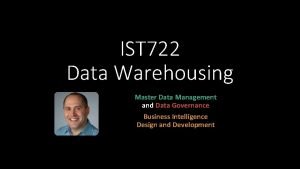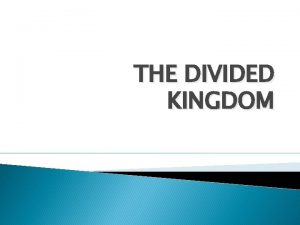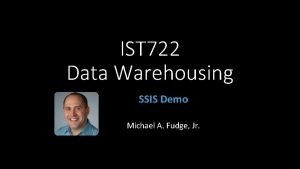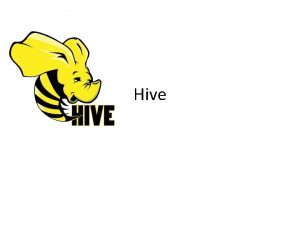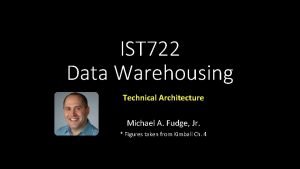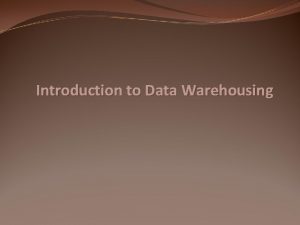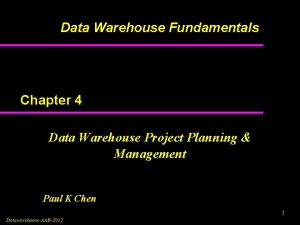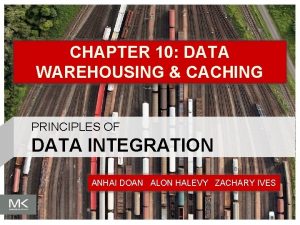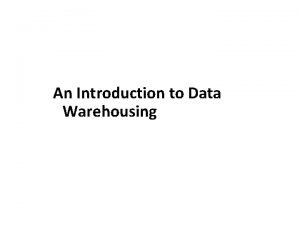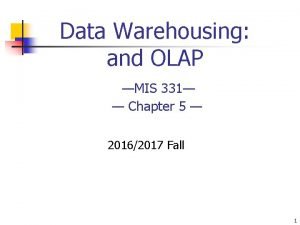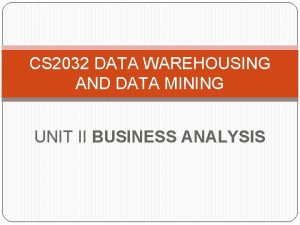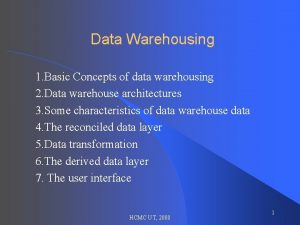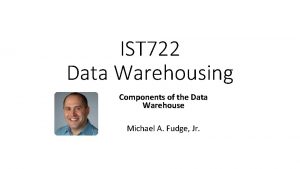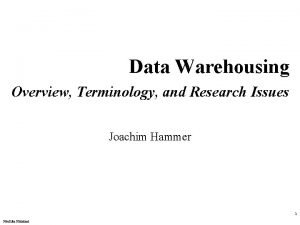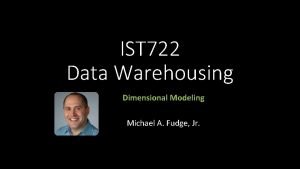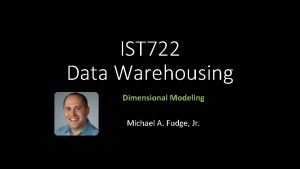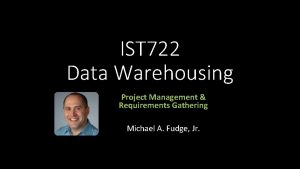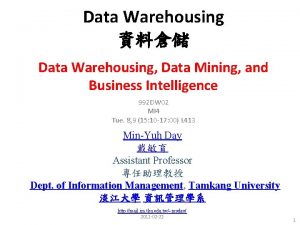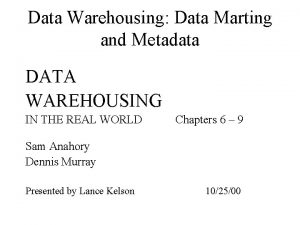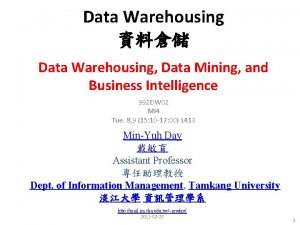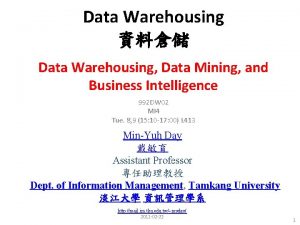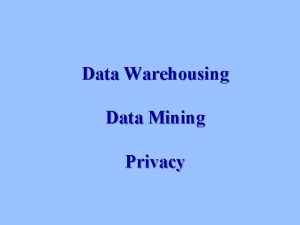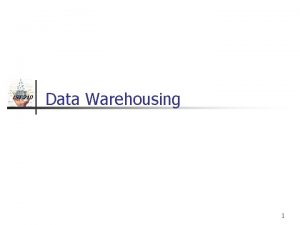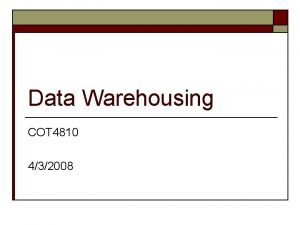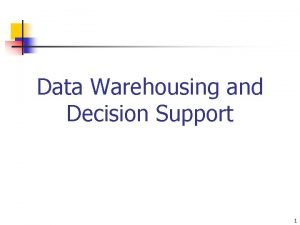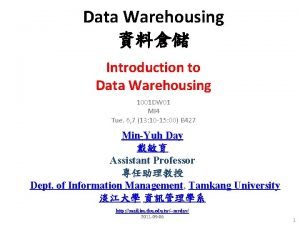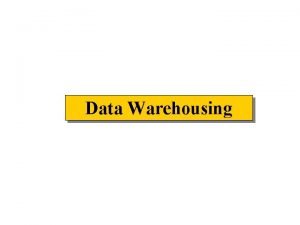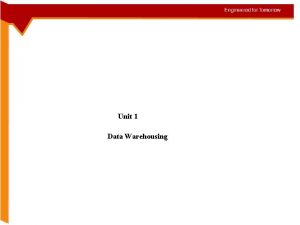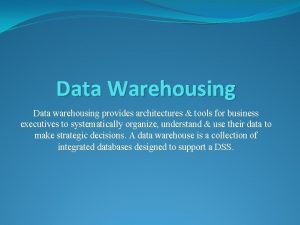IST 722 Data Warehousing Technical Architecture Michael A

























- Slides: 25

IST 722 Data Warehousing Technical Architecture Michael A. Fudge, Jr. * Figures taken from Kimball Ch. 4

Objective: Understand the technical architecture required by the data warehouse.

Recall: Kimball Lifecycle

Architecture != Infrastructure Technical Architecture Technical Infrastructure • A Framework of rules, decisions, and structures for the overall design of a system. • A physical means of implementing a technical architecture through hardware and software. It’s how we Conceptualize the Data Warehouse is built!

The Data Warehouse Maturity Model Technical Architecture Must be addressed At GULF And CHASM

5 Technical Architectures 1. 2. 3. 4. 5. Independent Data Marts Enterprise Bus Architecture Hub And Spoke Centralized Federated We must choose a technical architecture to mature our data warehouse.

Independent Data Marts • Ad hoc “grassroots” technical architecture • Departmentalized, lacking enterprise focus. • No Consistency or data integration • Do not share dimensions • Data is sourced independently. External World Sales Inventory Payroll Forecasting

Enterprise Bus Architecture • Kimball Technical Architecture • Enterprise Focus • Consistent • Conformed Dimensions (reused) • Data is sourced systematically External World Stage Data Warehouse: Dimensions & Fact Tables

Hub And Spoke • Inmon Technical Architecture • Enterprise Focus • Data warehouse does not have Dimensional Models, but time variance. • Data Sourced Systematically • Dimensional Models in Data Marts External World Stage Data Mart Data Warehouse: 3 NF + Time Variance, MDM Data Mart

Centralized Data Warehouse • Similar to Hub and Spoke but without the dependent data marts. • Contains Atomic Data, Summarized data, time-variant data, and Dimensional Models External World Stage Data Warehouse: 3 NF + Time Variance, MDM, Dimensional Models

Federated Data Warehouse • Most Complex • Service-oriented Architecture • Used to integrate existing Data Marts, Warehouses and legacy applications into a single logical data warehouse. Data Warehouse

Which Technical Architecture? • Urgent need? • MDM Strategy? • Need to Integrate existing data warehouses? • Grow organically? • Simplified enterprise Focus?

Which Technical Architecture? • Urgent need? • MDM Strategy? • Need to Integrate existing data warehouses? • Grow organically? • Integrated Data-Mart Focus? • Independent Data Marts • Hub-And-Spoke • Federated Architecture • Centralized Data Warehouse • Enterprise Bus

Check Yourself KIMBALL TECHNICAL ARCHICETURE • What Kimball mean by: • “front room architecture”? • “back room architecture”? • What are the 3 main system architectures of the model? • ?

Kimball: DW/BI System Architecture Model * Figure 4 -1 from Kimball text

Back Room and Front Room Architectures Back Room Front Room • Behind the scenes. • No direct interaction with the business users. • Business users see and interact with this architecture.

3 System Architectures 1. Back-Room: ETL System (We’ll cover this next class) 2. Back-Room and Front Room: Presentation Server (We’ve covered this already) 3. Front-Room: BI Applications (We’ll cover this in 2 classes)

Metadata • The information that describes our technical architecture. • Spans all 3 System Architectures: Back, Presentation & Front. • Technical Metadata – Infrastructure oriented. Indexes, table partitions, data types, data transformations. • Business Metadata – User oriented. Data structure definitions, Data dictionaries, implicit data hierarchies. • Process Metadata – System oriented. Performance metrics and measurements. The Audit Dimension.

Back Room Architecture • Behind the scenes. • No direct interaction with the business users. • ETL System + Parts of the Presentation Server

Presentation Server Architecture • Dimensional Models as ROLAP Star Schemas, MOLAP Cubes • Enterprise Bus Architecture • Conformed Dimensions across fact tables.

Front-Room Architecture • Business users see and interact with this architecture. • Business Intelligence • Reports, Cube Explorers, Data mining, Dashboards, Scorecards.

Kimball v Inmon • Compare and contrast to the CIF: • Front / Back Room? • ETL / PS / BI? • Similarities? • Differences?

Kimball v Inmon • Compare and contrast to the CIF: • Front Room • Presentation • Back Room • Similarities? • Differences?

A Closing Group Activity - More Product Evals! • Research the following products. • What does it do? • How does it fit within the Kimball architecture? • Front room? • Presentation Server? • Back Room? • Do you need your own infrastructure? Three Products: • Board (http: //www. board. com) • Snaplogic (http: //www. snaplogic. com) • Spark (https: //spark. apache. org) Take 18 Minutes!

IST 722 Data Warehousing Technical Architecture Michael A. Fudge, Jr.
 Sumyslice
Sumyslice A kingdom divided
A kingdom divided Ssis-722
Ssis-722 Grammer 722
Grammer 722 Grammar
Grammar What is kdd process in data mining
What is kdd process in data mining Hive provides data warehousing layer to data over hadoop
Hive provides data warehousing layer to data over hadoop Olap data mart
Olap data mart Data warehousing olap and data mining
Data warehousing olap and data mining Data warehousing best practices
Data warehousing best practices Introduction to data warehouse
Introduction to data warehouse Front room vs backroom data warehousing
Front room vs backroom data warehousing Operational and informational data store in data warehouse
Operational and informational data store in data warehouse Greenplum data warehousing
Greenplum data warehousing Data warehouse component
Data warehouse component How to plan a data warehouse project
How to plan a data warehouse project 1keydata data warehousing
1keydata data warehousing Data warehousing principles
Data warehousing principles An overview of data warehousing and olap technology
An overview of data warehousing and olap technology Introduction of data warehouse
Introduction of data warehouse An overview of data warehousing and olap technology
An overview of data warehousing and olap technology Concept hierarchy in data warehousing
Concept hierarchy in data warehousing Cs 2032
Cs 2032 Basic concept of data warehousing
Basic concept of data warehousing Inmon cif
Inmon cif Research problems in data warehousing
Research problems in data warehousing
